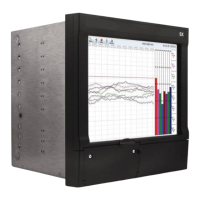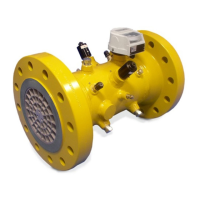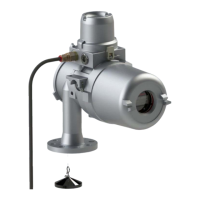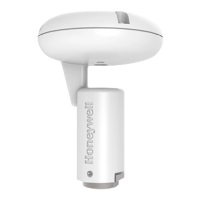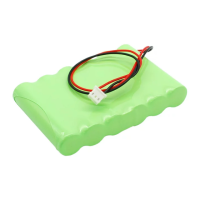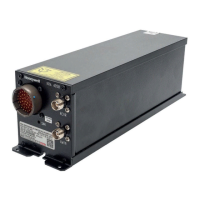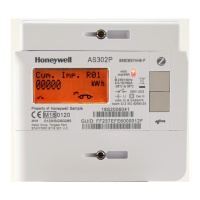42 Honeywell Sensing and Control
Signal Conditioning, Self Calibrating Digital Indicators
Rev. G, 008-0608-00
DISPLAY. UNITS Menu Item
Specifies the four character label that is displayed to the right of
the channel’s values.
NOTICE
This menu item doesn’t change the mathematical scaling of
the channel’s values; that can be changed by altering the
“CALIBRATION DATA -> KNOWN POINT X/Y” menu items and then
performing a re-calibration.
When a character position is flashing press the [UP] or [DOWN]
button to change the character. Press [ENTER] to advance to the
next character.
DISPLAY. AVERAGE Menu Item
Controls the speed with which the channel’s display values will
update. Display averaging does not affect the channel’s analog
output or its peak/valley detection, which will proceed at the
speed selected by the ”OPERATION -> FREQ. RESPONSE” menu item.
The choices are:
• “ON” means that the display will update four times each sec-
ond. The channel’s values will be averaged for 1/4 second,
then displayed.
• “OFF” means that the channel’s display will update as quickly
as possible.
11.5.3 AUXn FUNCTION Menu Items
The AUX1 FUNCTION and AUX2 FUNCTION menu items determine
what happens when the Auxiliary Function pins (labeled as
“AUX1” and “AUX2”) on the channel’s connector are activated.
These pins are “activated” when they are connected to the
DGND pin. The choices are:
• “DISABLED” means that activating the pin does nothing.
• “TRACK HOLD” means that the tracking, peak and valley values
will not be updated.
• “HIGH/LOW HOLD” means that the peak and valley values will
not be updated.
• “HIGH/LOW CLEAR” means that the peak and valley values are
reset.
• “TARE ON” activates the channel’s Tare function (resets it to
zero).
• “TARE OFF” deactivates the channel’s Tare function.
As the Auxiliary Function pins are not isolated, it is recommended
that a push-button switch or relay is used to connect these pins
to the DGND pin.
11.5.4 CALIBRATION TYPE Menu Item
The choices for this menu item are:
• “TYPE= 2 POINT CAL” means 2-Point Known Displacement
Calibration. You are prompted to apply the displacements
to the transducer that were entered in the “KNOWN POINT 1/2”
and “KNOWN POINT 2/2” registers. This technique assumes
that the transducer is linear throughout the entire stroke, so
the usual displacements used are zero scale and full scale.
• “TYPE= 3 POINT CAL” means 3-Point Known Displacement
Calibration. You are prompted to apply the displacements
to the transducer that were entered in the “KNOWN POINT 1/3”
and “KNOWN POINT 2/3” and “KNOWN POINT 3/3” registers. This
technique can be used to compensate for the different sen-
sitivities that an LVDT may have on each side of its electrical
null. The usual displacements used are zero scale, half scale
and full scale, but you are not restricted to these displace-
ments.
• “TYPE= 5 POINT CAL” means 5-Point Known Displacement
Calibration. You are prompted to apply the displacements to
the transducer that were entered in the “KNOWN POINT 1/5”,
“KNOWN POINT 2/5”, “KNOWN POINT 3/5”, “KNOWN POINT 4/5”
and “KNOWN POINT 5/5” registers. This technique can be used
to compensate for the non-linearity in the transducer as well
as the different sensitivities on each side of its electrical null.
The usual displacements used are zero scale, one-quarter
scale, half scale, three-quarters scale and full scale, but you
are not restricted to these displacements.
The selection of the calibration type affects what menu items ap-
pear in the CALIBRATION DATA sub-menu.
11.5.5. CALIBRATION DATA Sub-Menu
This sub-menu enters the values that will be used by the instru-
ment when it calibrates itself to the transducer. The menu items
that are displayed will change according to what the CALIBRATION
TYPE is set for.
FULL SCALE VRMS Menu Item
The transducer output when its full-scale displacement is applied
to it, in Volts RMS (root-mean-squared) assuming 3 VRMS excita-
tion. This menu item is used by the instrument to set gain of its
amplifier circuit. This value is normally found on the transducer’s
Certificate of Calibration issued by its manufacturer.
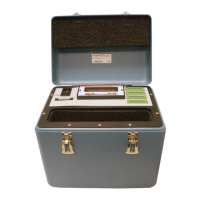
